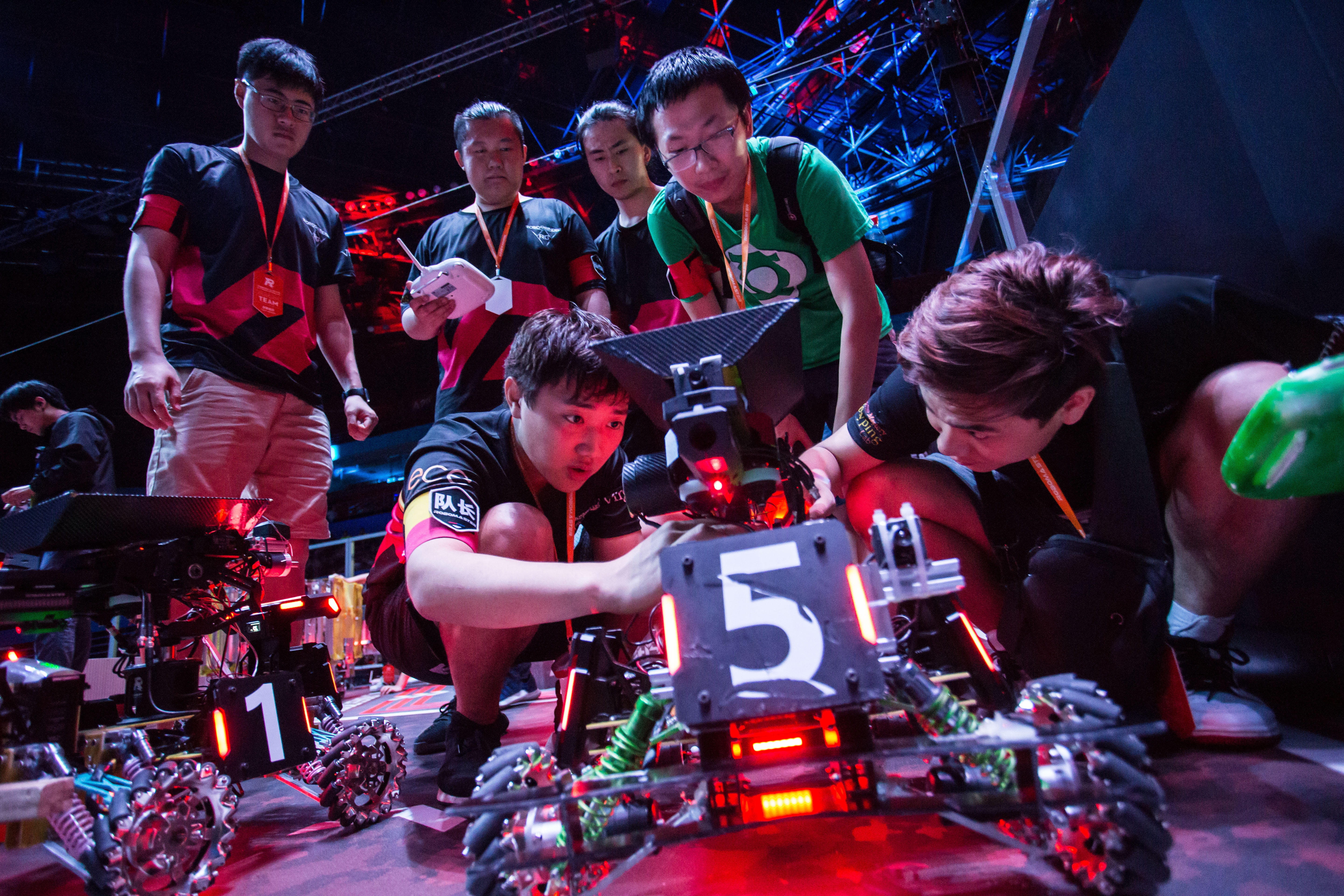Robogrinder
May 20, 2019

- Building a robot from scratch—overnight.
- Living with 15 roommates— in a three-bedroom house.
- Forgoing Friday night parties, weekend activities, and holiday breaks—to create a competitive team of robots.
These and other self-inflicted rigors, which captain Yipin Zhou admits to with a laugh, demonstrate the passion exhibited by the Virginia Tech RoboGrinder team, which placed in the second tier of the final RoboMaster Robotics competition in July 2018.
Sponsored by Chinese-based company DJI, RoboMaster is a robotics competition that pits university teams against each oth-er in a tournament that combines technical prowess with team strategy.
As one of the international teams in the 2018 tournament, RoboGrinder had an extra set of hurdles: they had to scramble to find affordable parts on their tight schedule, and much of the team relocated to China for two-and-a-half months to unpack, assemble, and test their seven robots.
Home base in China was a small apart-ment in Foshan, about 60 miles from where the competition would be taking place. Space was so tight that the teammates slept among their robots. (Although, this wasn’t exactly unusual, says Zhou, who described similar sleeping conditions during late night lab sessions in Blacksburg.) By day, they taught local students in exchange for air-condi-tioned work space in a nearby high school. By night, they built robots.
Their dedication paid off during the July international regional competition where they placed among the grand prize winners.
Three days later, international and Chinese finalists (the latter of whom had emerged from the Chinese regional compe-tition two months earlier) faced off in the final tournament.
In the ring
Every team in the 2018 Robomaster competition had seven robots in the ring: three infantry robots, a hero, a guard/sen-try, an aerial drone, and an engineer ro-bot. They engaged in brutal exchanges of projectiles—small rubber balls—on a battle-ground studded with obstacles, attempting to score hit points and take out the other team’s base.
Equipped with a grabbing mechanism to pick up buckets of ammo, the hero robot was powered by an STM32-embedded sys-tem, which controlled the air cylinder, chas-sis motor, and gimble motor.
The three nimble infantry robots were deployed to catch and trap the enemy hero robot. RoboGrinder’s infantry model was equipped with a custom supercapacitor, which allowed the team to bump up the chassis power to 900 watts—far exceeding the 80 watts achieved by competing teams using off-the-shelf components.
The team used linear actuators to con-trol their 2018 engineering robot. This made it easy to control, says Zhou, but slow—a critical flaw for the robot that served as the mobile arsenal.
The guard robot, which defended the base, employed computer vision to detect the enemy, and the aerial drone with the shooting mechanism on the bottom provid-ed support from above.
With the exception of the fully autono-mous guard robot, the machines were remote-ly controlled off-ring. But who got to drive?
“We picked the person who had the most first-person shooting (FPS) games ex-perience,” says Zhou. “He had like 2,000 FPS hours. And he did a great job.”
Post-game
After the tournament concluded, the students packed up their robots and shipped them overseas—back to the U.S. Three months later, the packages were finally de-livered on November 6—a Friday night.
“No one went out to any parties or any-thing that night,” says Zhou. “We were get-ting our babies back!” A group of students spent the whole night disassembling them and worked late into the next morning to get them running again.
Back in Blacksburg
In 2016, the multidisciplinary team had nine members. But after the 2018 compe-tition, an interest meeting drew about 200 students, and the official team roster swelled to about 90 members—35 members from ECE, 30 from mechanical engineering, and the rest from computer science, math, phys-ics, architecture, finance, business, and in-dustrial and systems engineering.
RoboGrinder veterans have been con-ducting tutorials to get new students up to speed. A computer science/computer engi-neering double major, for instance, has been offering C++ lessons to his teammates, while a mechanical engineering major holds regu-lar CAD modeling sessions.
Students are involved in one or more of RoboGrinder’s four branches: ECE, me-chanical engineering, computer vision, and operations/outreach.
In November, the team approached Alexander Leonessa, a professor in mechan-ical engineering and in ECE by courtesy ap-pointment, who agreed to act as advisor.
“It’s inspiring to work with a team with so much motivation and focus,” says Leonessa. “Their achievements have already made all of us proud, and I am sure they will accomplish great things this year.”
Besides the extra expertise and profes-sional guidance, the team now has access to an off-campus space, where they can plan their own battlefield, and to the Trec Lab Machine Shop.
With these resources, the extra train-ing, and the reinforced team, RoboGrinder has sights set on even higher honors in the 2019 Robomaster competition. But, as Zhou is quick to point out, the real win comes from working together to apply engineering.
“We hope our team can become a plat-form for any Virginia Tech student. Our working environment is also a really good learning environment.”
Please enjoy this brief video created by one of our Robogrinder students.


